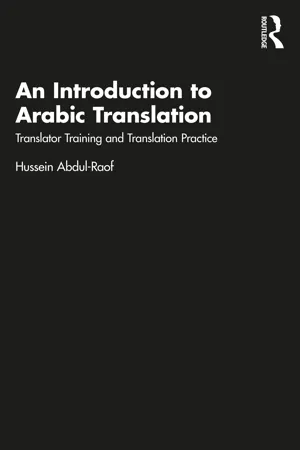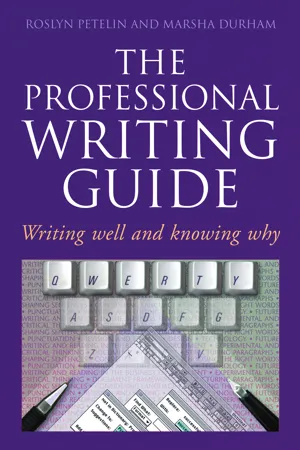Languages & Linguistics
Jargon
Jargon refers to specialized terminology or language used within a particular profession, industry, or interest group. It often includes technical or complex terms that may be unfamiliar to those outside the specific field. Jargon facilitates efficient communication among insiders but can be a barrier to understanding for those not familiar with the specialized vocabulary.
Written by Perlego with AI-assistance
Related key terms
Related key terms
1 of 4
Related key terms
1 of 3
4 Key excerpts on "Jargon"
- eBook - ePub
An Introduction to Arabic Translation
Translator Training and Translation Practice
- Hussein Abdul-Raof(Author)
- 2022(Publication Date)
- Routledge(Publisher)
A Jargon is defined here as any foreign expression that is non-existent in Arabic and that has been borrowed through a given Jargon production approach. Thus, words like (cloud, pen) are not considered as Jargon because Arabic has already got them (سحابة ,قلم). Thus, a Jargon is a TL word or a noun phrase.A Jargon is referred to as علمُ المُصطلح/المُصطلحية/إصطلاح/مُصطلح – a specialized terminology which designates a specific notion of any field of knowledge (science or human sciences) and may not be understood well without a context. Jargon is a universal lexical phenomenon, and languages have always borrowed different Jargon from each other. The borrowing of a SL Jargon by a TL is attained through different linguistic approaches which mimic the SL Jargon in an attempt to preserve the semantic componential features of the original Jargon and naturalize (domesticate) it in the receptive language, taking into consideration the TL linguistic and cultural norms and values. The newly born Jargon can be a lexical item, a morpheme, or a noun phrase. The creation – or rather, the borrowing – of Jargon from other languages represents the inter-cultural fertilization among both linguistically and culturally related or unrelated languages.Seven linguistic approaches are proposed for the creation of a Jargon in the TL. Throughout the discussion, several examples are provided to illustrate the seven linguistic mechanisms which can be employed to create a new Jargon in science or human sciences. The semantic relationship between the SL Jargon and the Jargon borrowed by Arabic is explained. Among the most common linguistic approaches (mechanisms) used in the creation of a new Jargon and loan words in Arabic are phraseological calque, borrowing, and blending. It also deals with phonetic imitation (transliteration) and semantic matching between the foreign Jargon and the newly coined Arabic Jargon.According to Jakobson (1959) - eBook - ePub
Professional Writing Guide
Writing well and knowing why
- Roslyn Petelin(Author)
- 2023(Publication Date)
- Routledge(Publisher)
Chapter 9 Choosing the Right Word In this chapter we deal with Jargon in its various forms, cliches, colloquialisms, coinages, wordiness, equivocation, foreign words and phrases, confusable words, and commonly misspelt words—essential aspects oflanguage use within the business context. What is Jargon? When visitors looking for the monkeys at a zoo are confronted with a sign which says ‘To the Arboreal Primates’, we see Jargon at work. Jargon, a type of specialised vocabulary used in various fields and professions, is a constant target of criticism from readers of business documents, who complain that documents like letters and insurance policies are difficult to understand because they are full of Jargon. It is unfortunate that Jargon has accumulated these negative connotations, because eliminating Jargon completely would deprive business writers of valuable shortcuts. For example, it is doubtful whether reporting of stock market activities could function as efficiently without terms such as the ‘All Ordinaries Index’, ‘weighted averages’, ‘blue-chip stocks’, ‘bull-and-bear markets’, and the ‘P/E ratio’. Jargon is often justifiable and sometimes indispensable. However, you should use it carefully.To use it for its own sake, or to obscure or confuse, will probably alienate your readers. Buzz Kennedy (Weekend Australian, 29 April 1989), laments that ‘today's specialists crouch complacently behind their Jargon barriers and … Look with pity on those of us who have no inspeak’. General readers often have great problems with the Jargon in certain fields. For example, it has been suggested that Jargon used in the investment and superannuation fields ‘frightens’ potential investors. Apparently, many ordinary investors fail to earn dividend income which is tax-free because they do not understand the term ‘dividend imputation’ and thus remain ignorant of its benefits - eBook - ePub
European Vernacular Literacy
A Sociolinguistic and Historical Introduction
- Joshua A. Fishman(Author)
- 2010(Publication Date)
- Multilingual Matters(Publisher)
A commonly used unabridged dictionary suggests a typical beginning definition of language as: ‘the way human beings communicate using words, whether written or spoken. It is also used for the particular system of communication used by a specific country, nation or community’ (Encarta, 1999: 1013). This particular dictionary then goes on to explain that ‘language’ is not the only way that individuals communicate and that it includes such subsidiary varieties as idiolects, dialects, slang, Jargon, parlance, lingo, etc. The above overall definition could easily be ‘filled out’ by mentioning various further varieties of language, for example, occupational varieties, levels of formality in language, levels of seriousness in language, use of metaphor in language, related and unrelated languages, child language, animal languages, disturbed language, international and classical languages and so on. Gradually, what we originally took to be a simple, popular term, with a common meaning easily available to one and all, manifests itself to be full of unexpected complexities related to its widely differentiated users and uses. Obviously, only a modicum of reflection has revealed that there is nothing at all inherently simple about words such as ‘language’ and ‘languages’, since they reflect and convey all of the motivational and behavioral differences of the species that employ them, both to reveal and to disguise their goals, values and characteristics.Indeed, the dictionary’s approach quickly becomes unwieldy, as soon as we seriously try to make it apply to all of the widely known uses and users of language varieties. This type of recitation of ‘varieties of varieties’ also suffers from its laundry list character. There is no rhyme nor reason to the order in which we have listed them, nor any seeming relationship between these varieties, nor any attempt to cope with the obvious ephemerality and peripherality of some and the eternality and centrality of others to the human condition. There must be another way, hopefully a better one, to view language and languages, one that takes us closer to our main goal, namely, an explication of what may be a constantly ongoing saga: the birth and death of languages throughout the centuries of dramatically unequal human societies living in both internal and external interaction. - eBook - ePub
The Vocabulary of Modern French
Origins, Structure and Function
- Hilary Wise(Author)
- 2003(Publication Date)
- Routledge(Publisher)
Can a clear distinction be made between this lexis and argot ? We could perhaps say that the latter has more of a social than a strictly practical function; the exclusion of the outsider and the reinforcing of relationships within the group are the central functions of argot, but incidental in the exchange of Jargon. Close-knit social groups may of course form within a professional context, where working conditions foster camaraderie and interdependence. Two young doctors chatting about a case may well use different lexical items than a junior doctor discussing the same case with a senior colleague, just as an exchange between two privates in the same regiment would differ from one between a private and a senior officer, even on a technical topic. To refer to lexis of this kind, that has the dual functions of argot and Jargon, Sourdot (1991) has coined the useful term jargot. Such lexical items may be considered informal, in-group synonyms of technical terms, resulting from the various formal and semantic processes described above. Typically irreverent metonymies are to be found in the substitution of gazier or pousse-seringue for ‘anaesthetist’, and coupeur de mou for ‘surgeon’. Clipping is predictably the commonest device, giving réa for réanimation, and arrêt-car for arrêt cardiaque and une perf for perfusion ‘a drip’. One can imagine that as well as signalling camaraderie among a medical team, such abbreviated expressions can have the often useful function of being obscure to patients or their relatives. In military slang (Rousselot 1989), clipping is sometimes judiciously combined with re-suffixation, to produce puns such as juteux for adjutant, aspirine for aspirant féminin (that is, a female officer cadet). Doillon (1993) demonstrates the richness of the lexis, both technical and informal, that has developed in the field of sport
Index pages curate the most relevant extracts from our library of academic textbooks. They’ve been created using an in-house natural language model (NLM), each adding context and meaning to key research topics.
Explore more topic indexes
Explore more topic indexes
1 of 6
Explore more topic indexes
1 of 4



